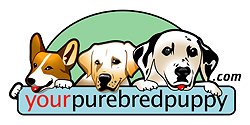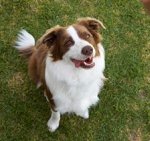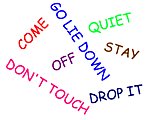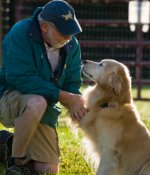Giant Schnauzers: What's Good About 'Em, What's Bad About 'Em
Giant Schnauzer temperament, personality, training, behavior, pros and cons, advice, and information, by Michele Welton, Dog Trainer, Behavioral Consultant, Author of 15 Dog Books

The AKC Standard calls the Giant Schnauzer "a bold and valiant figure of a dog – amiable in repose and a commanding figure when aroused."
His keen expression is what you may notice first about the Giant Schnauzer. This sensitive dog seems always aware of your moods and likes to be physically close to you, watching you.
Some lines are "harder-tempered" (bold, serious, vigorous) while others are much sweeter and more mellow.
But in general, when you acquire a Giant Schnauzer puppy, you should expect him to mature into an athletic, energetic dog who plays hard and needs a mile or two of walking and/or running each day.
Mental stimulation is just as important to this extremely intelligent dog.
Most Giant Schnauzers are watchful with strangers and responsible about protecting their home. However, timidity, skittishness, and sharp-shyness are seen in some lines. To promote a stable, confident temperament, Giant Schnauzers need more socialization than many other breeds.
Many individuals are too spirited for small children, and some become overprotective of their own kids when a group is engaging in rough-and-tumble play.
Strange dogs may well be challenged by your Giant Schnauzer. Cats may or may not be accepted.
Once you establish your leadership, the Giant Schnauzer responds very well to obedience training that is fair and consistent. But this highly intelligent, strong-minded working breed is often "too much dog" for many households.
If you want a dog who...
- Is large, athletic, and rather elegant-looking
- Has a wiry coat that doesn't shed too much and a whiskery face with a wise expression
- Plays hard and thrives on vigorous athletic activities
- Makes a keen watchdog and looks imposing, so also makes an effective deterrent
A Giant Schnauzer may be right for you.
If you don't want to deal with...
- Vigorous exercise requirements
- Rowdiness and exuberant jumping, especially when young
- Destructiveness when bored or not exercised enough
- Potential aggression or fearfulness in some lines, or when not socialized enough
- Potential aggression toward other animals
- Strong-willed mind of his own, requiring a confident owner who can take charge
- Regular clipping and trimming of the wiry coat
A Giant Schnauzer may not be right for you.
 |
Dog Breed Traits – Which Traits Are Right For You? In this brand new series, I'll help you decide which dog breed traits would best suit you and your family, your home and yard, and your lifestyle, so you can choose the best dog breed for your family. |
Keep in mind that the inheritance of temperament is less predictable than the inheritance of physical traits such as size or shedding. Temperament and behavior are also shaped by raising and training.
FREE eBooks by Michele Welton
![]() "Respect Training for Puppies" and "Teach Your Dog 100 English Words" are free step by step guides to teaching your pup to be calm and well-behaved.
"Respect Training for Puppies" and "Teach Your Dog 100 English Words" are free step by step guides to teaching your pup to be calm and well-behaved.
![]() "11 Things You Must Do Right To Keep Your Dog Healthy and Happy" is a free guide to keeping your dog mentally, physically, and emotionally happy and healthy so you can enjoy a longer lifetime of companionship.
"11 Things You Must Do Right To Keep Your Dog Healthy and Happy" is a free guide to keeping your dog mentally, physically, and emotionally happy and healthy so you can enjoy a longer lifetime of companionship.

- You can avoid some negative traits by choosing an ADULT dog from an animal shelter or rescue group. With an adult dog, you can easily see what you're getting, and plenty of adult Giant Schnauzers have already proven themselves not to have negative characteristics.
- If you want a puppy, you can avoid some negative traits by choosing the right breeder and the right puppy.
More traits and characteristics of the Giant Schnauzer
If I was considering a Giant Schnauzer, I would be most concerned about...
- Providing enough exercise and mental stimulation. Giant Schnauzers look athletic for a reason! They ARE athletic, which means they require plenty of exercise – not just a couple of walks around the block. If you don't take your Giant Schnauzer out to romp and play and do interesting things, he will become rambunctious and bored and then you'll see frustrated behaviors like barking and destructive chewing. Bored Giant Schnauzers can make a shambles of your house and yard.
- Providing enough socialization. Most Giant Schnauzers have protective instincts toward strangers. They need extensive exposure to friendly people so they learn to recognize the normal behaviors of "good guys." Then they can recognize the difference when someone acts abnormally. Without careful socialization, they may be suspicious of everyone, which could lead to aggression.
Some Giant Schnauzers go in the opposite direction – without enough socialization, they become fearful of strangers. Fearfulness in a Giant Schnauzer can also be dangerous because it can lead to defensive biting if the dog becomes frightened and feels cornered.
- Potential animal aggression. Many Giant Schnauzers are dominant or aggressive toward other dogs of the same sex. Some have strong instincts to chase and seize cats and other fleeing creatures. If anything goes wrong in the breeding, socializing, training, handling, or management of this breed, it is capable of seriously injuring other animals.
- The strong temperament. The best Giant Schnauzers are versatile working dogs, capable of learning a great deal. But they have an independent mind of their own and are not pushovers to raise and train. Some Giant Schnauzers are willful and bossy and will make you prove that you can make them do things. You must show them, through absolute consistency, that you mean what you say. Read my free online training programs.
- Lots of grooming. Giant Schnauzers don't shed a great deal – though they are not hypoallergenic. The trade-off to less shedding is a commitment to coat care. Giant Schnauzers require clipping and trimming every few months. Breed purists may say that the wiry coat should never be clipped because it makes the coat softer and more prone to matting. Instead they advocate hand-stripping (each dead hair pulled out so a new one can grow in its place). But in my opinion, stripping is too time-consuming and uncomfortable for the dog. Many groomers won't do it anymore. For pet dogs, I think clipping is just fine.
My best-selling books – now available FREE on my website
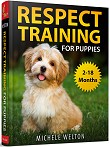 Respect Training For Puppies: 30 seconds to a calm, polite, well-behaved puppy is for puppies 2 to 18 months old. Your puppy will learn the 21 skills that all family dogs need to know. Click here to read for free.
Respect Training For Puppies: 30 seconds to a calm, polite, well-behaved puppy is for puppies 2 to 18 months old. Your puppy will learn the 21 skills that all family dogs need to know. Click here to read for free.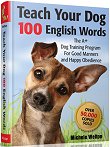 Teach Your Dog 100 English Words is a unique Vocabulary and Respect Training Program that will teach your adult dog to listen to you and do what you say. Click here to read for free.
Teach Your Dog 100 English Words is a unique Vocabulary and Respect Training Program that will teach your adult dog to listen to you and do what you say. Click here to read for free.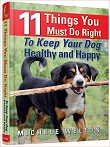 11 Things You Must Do Right To Keep Your Dog Healthy and Happy helps your dog live a longer, healthier life. Get my honest advice about all 11 Things before you bring home your new puppy, because some mistakes with early health care cannot be undone. Click here to read for free.
11 Things You Must Do Right To Keep Your Dog Healthy and Happy helps your dog live a longer, healthier life. Get my honest advice about all 11 Things before you bring home your new puppy, because some mistakes with early health care cannot be undone. Click here to read for free.Related posts you might enjoy
